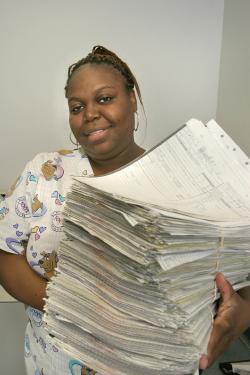|
Issue Date: March 19, 2004
Trauma unit meter runs at $5,000 a minute Like other Catholic hospitals around the country that adopt an outreach-to-all approach, St. Francis Medical Center in Lynwood, Calif., has to balance budget and belief in the midst of traumas that, in the final analysis, come down to caring for sick and dying people one person at a time -- then finding the money to pay for it. This is the final segment of a three part series on the medical center.
By ARTHUR JONES Violent death comes with a price. Not only in the tragic loss of the unlived life -- as with the young man who died of bullet wounds on the trauma room table -- but also in dollars and cents. From the moment the young man was gurneyed into the Daughters of Charity-founded St. Francis Medical Center emergency department here as a “Code Yellow” (NCR, Jan. 23) until he died less than 20 minutes later, the cost clock was ticking -- at the rate of about $5,000 a minute.
“That particular patient was over $100,000,” said Gerald “Jerry” Kozai, St. Francis president and CEO. Kozai continued, “With a team of 10 to 15 people responding immediately to any kind of trauma -- in-house surgeons, ER nurses, specialists, etc. -- the infrastructure costs of a high quality trauma center are tremendous.” Because of costs, many hospitals in Los Angeles County and Southern California have closed their trauma centers (and another is currently threatened). In defiance of the trend, in the early 1990s St. Francis opened its trauma center. The argument was simple: The surrounding community needed it. Where the Daughters of Charity Health System is concerned, community needs set the priorities. But what about costs? Answering those questions covers a spectrum that ranges from political advocacy and ruthless monitoring of expenses, to 60 men and women on BMW motorcycles -- and the fate of an aggressive old man abandoned in St. Francis emergency room. Answers have to do with the “Angels of Mercy” painted on a wall in the Family Life Center, with balls and golf tournaments. All the activities and solicitations and appeals to foundations that bring in the money that provides the hospital’s extremely thin margin of safety.
Said Kozai: “You hear of some CEOs -- I’m thinking of a recent article in Modern Healthcare -- saying it’s ‘margin versus mission.’ At St. Francis we don’t believe that. Speaking for the Daughters of Charity, we believe that if you stay true to the mission the margin will be there.” The trauma center, he said, “is not a choice. All the decisions we make are based on the mission.” But that doesn’t mean sitting back and hoping the money will come. St. Francis has a separately established St. Francis Foundation that focuses full-time on raising the money, and isn’t shy about lobbying county supervisors for help in obtaining state and federal funds. Carol Lee Thorpe, the foundation’s chief operating officer and vice president for community services, explained how the hospital survives. “Number one, we’re very focused. We’re universally clear that our financial viability is the platform on which we do the work, the platform from which we carry out the mission. Number two, we monitor our expenses ruthlessly. Next, we collect every possible reimbursement available. Then we supplement that with philanthropic support.” Kozai said the hospital benefited from a successful 2003 Los Angeles County referendum. “Successful,” he said, “because county residents felt that maintaining these trauma centers was in the best interests of public health.” Slim margins, said Kozai, “are why the advocacy agenda is so important. It’s why [Daughters of Charity] Sr. Joyce [Weller, chair, St. Francis board of trustees] and I have gone to Washington. We really need to get the word out.” Some Washington officials think double-digit margins are the reality, he said. “We explain the reality.” Hospitals dedicated to serving the needy do not spin off high profits. Margins are slim in Southern California anyway -- roughly 2 to 3 percent of total revenue. St. Francis is a half-billion dollar-plus financial operation -- $550 million in inpatient and outpatient revenues -- with a miniscule operating margin: $7.5 million in 2003. Think of $7.5 million this way: It’s about 68 Code Yellows. And even that thinnest of cushions isn’t guaranteed. St. Francis raises much of that $7.5 million the hard way, from philanthropic support. Thorpe said the foundation has brought in between $5 million and $6 million annually for the past three years. One weekend every October, St. Francis’ supporters could be forgiven for confusing BMW marque roundels with St. Christopher medals. That’s because -- varooming off on a sponsored three-day trip through California’s scenic wonderland -- more than 60 riders raise more than $60,000. Special events manager Araceli Oliva doesn’t put on a crash helmet. But she does organize the event, plus a fall golfing extravaganza and a mid-summer charity ball.
The “Angels” painting on the hospital wall is one way in which the patients, staff and the institution itself say thanks to the donors listed under it -- and to the many donors who prefer to remain anonymous. Those who throw their legs across a booming-Beemer bike or come to dance or golf don’t just gather to give. They come to listen and learn. “The money raised is important,” said Thorpe, “but the ulterior motive is to introduce people to St. Francis Medical Center who would otherwise be oblivious to us.” The center’s “angels” sponsor events -- paying anywhere from $3,500 to $15,000 for a table at the ball, up to $10,000 to sponsor a golf foursome. Thorpe said, “The ball sponsors children’s programs so, with a video presentation, singers and a couple of people who say a few words -- nothing heavy -- we make sure everyone leaves knowing what we’re doing.” Held in the Los Angeles’ Ritz-Carlton, the ball raises around a quarter-million dollars. The golf competition brings together 144 golfers, “and a few extras,” said Thorpe, and there’s a certain amount of cachet in who it attracts to the Palos Verdes Country Club. Several years ago, said Thorpe, “a friend of a friend of a friend brought baseball star Eric Karros, and he’s been with us ever since. Now he brings baseball guys.” But it isn’t always the big names who win the golfing day. Two years ago two teenagers, Eric and Ryan Moosa -- sons of St. Francis physician Andy Moosa, were star performers with a foursome that wiped the floor with the competition. The tourney nets around $150,000. To see St. Francis Medical Center in isolation, however, would provide a skewed view of what’s really going on in Catholic medical care. The seven-hospital system of this Western Province of the Daughters of Charity Health System is emblematic of the daily and long-term changes and pressures felt by most Catholic hospitals and most Catholic systems. Board chair Weller explained that to survive organizationally, Catholic hospitals -- like most health care delivery groups -- combined in the 1990s into megasystems. Her province, for example, was a founding member of Catholic Healthcare West. “It made good sense at the time,” she said. “The whole model of savings and economies of scale and decentralization came in.” Catholic Healthcare West grew dramatically. Weller described it as “a good system.” However, she said, subsequent experience suggested “that because our mission is so comprehensive and so community-based, we could do the mission better being smaller, by managing facilities at the local level rather than the system level.” In 2001, the seven-hospital Daughters of Charity Health System withdrew from Catholic Healthcare West and returned to being a small regional system with hospitals in Northern and Southern California. Small Catholic systems do not operate in isolation. The week Kozai and Weller spoke with NCR, they had just attended a regular meeting with Los Angeles Cardinal Roger Mahony that brings together the major local Catholic systems -- the Daughters of Charity, Catholic Healthcare West, Providence Health System and Sisters of St. Joseph of Orange. All are committed to community care in Southern California. In health care, the Los Angeles region is in upheaval with state and county budgetary cutbacks, the county health system reeling, and for-profit hospitals owned by scandal-plagued Tenet health system up for sale. Los Angeles’ Martin Luther King Hospital is fighting for accreditation survival, and the major rehabilitation center, the county-operated Rancho Los Amigos, has, if only temporarily, forestalled closure threats. The Catholic systems’ work is interlaced with that of county health and other secular hospitals. A major challenge is ensuring that patients are tracked into the correct facility. Weller gave an example. “The fact that [St. Francis] turns no one away doesn’t mean we don’t find appropriate placement. A couple of weeks ago we found a disoriented and disheveled and very hostile man in the outpatient department with a note pinned on him: ‘We can’t take care of him anymore.’ ” The man, said Weller, “was brought in, treated medically and respectfully, and cleaned up. He kept trying to bite the nurses’ hands. He grabbed the doctor’s hand. The doctor thought he was going to be bitten and the man kissed it.” It took a while to trace the man’s background, find his records in the county system, and then transfer him to a county facility. The point, though, is quite clear. When the man was in a Catholic hospital, whether he was trying to bite or kiss the hand that helped him, he was “treated respectfully.” The dignity of the individual came first. Arthur Jones is NCR editor at large. His e-mail address is arthurjones@comcast.net. National Catholic Reporter, March 19, 2004 |
 Urban hospital finds ways to meet costs
Urban hospital finds ways to meet costs
